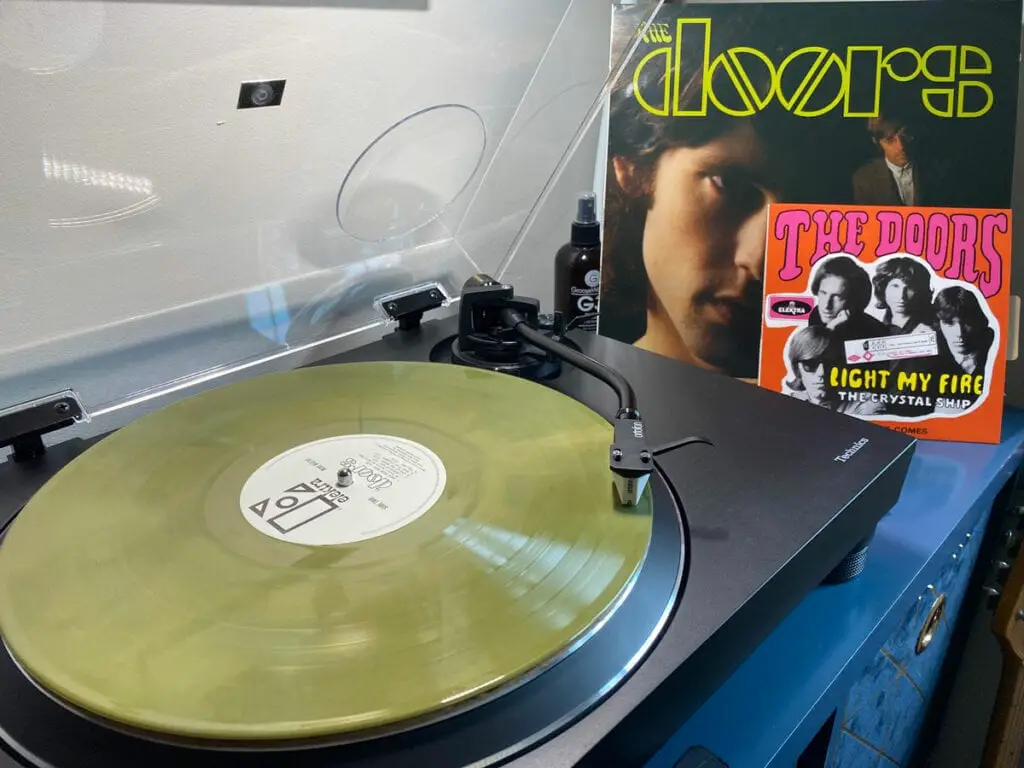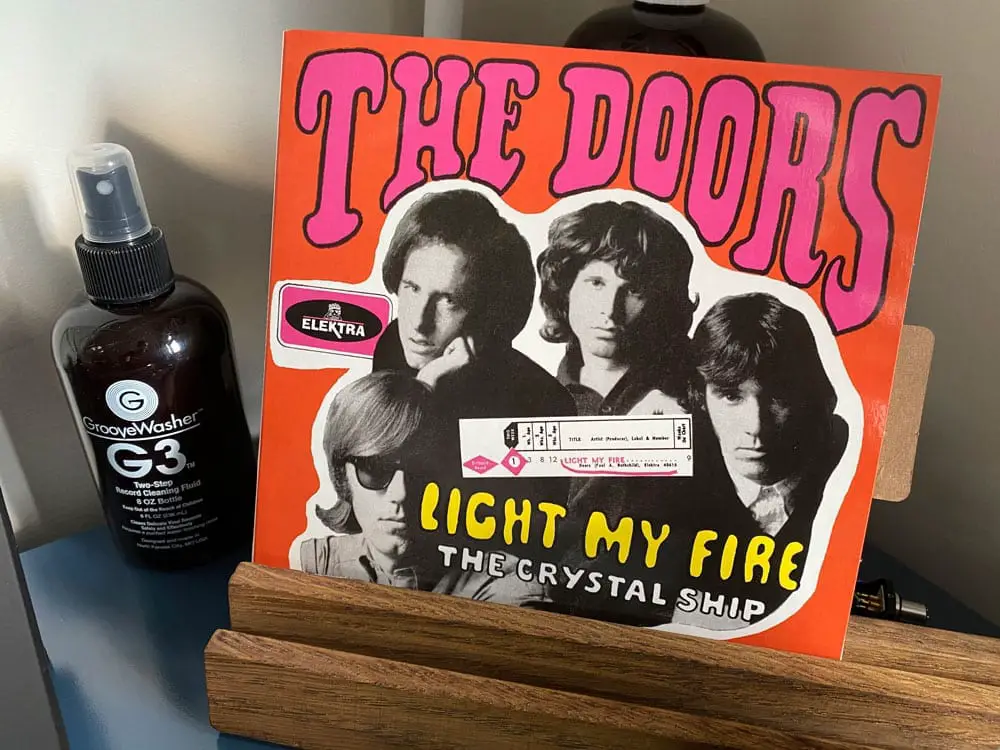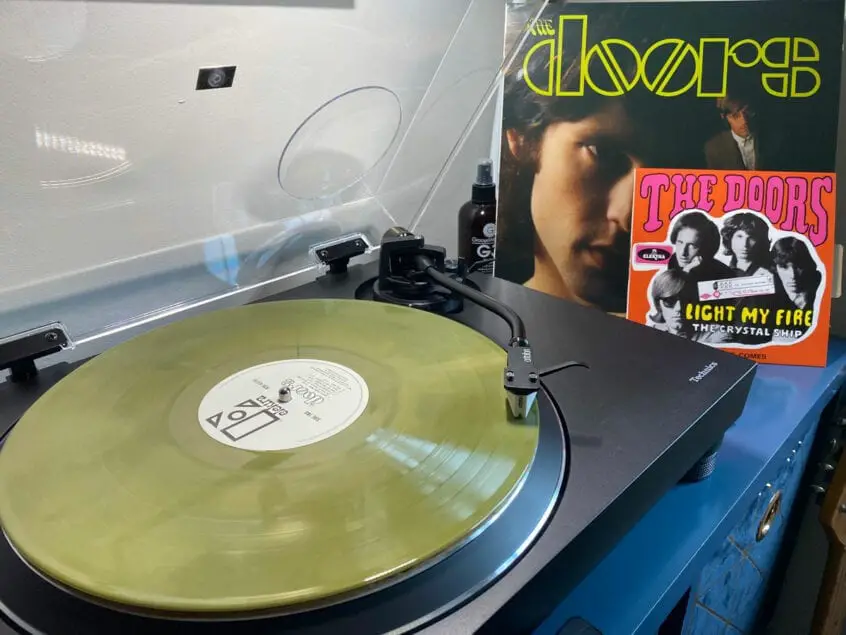The Doors debut album is a true classic rock album that pushed boundaries, opened minds and explored universal topics of self-exploration that make it as relevant today as the day it was released. To say The Doors is a classic album would be a severe understatement. Iconic and era-defining are better words to describe an album at the center of America’s counter-culture.
Keep scrolling for the full review, or watch the video review embedded in this article.

When an album is regarded classic, it is perfect in every way. By that, I mean they take on a life of their own, and you wouldn’t want to change a thing. There’s a kind of magic and alchemy that takes place in the studio; it’s difficult to put your finger on it, but it’s the secret ingredient that makes an album stand out. You can’t manufacture it, you can’t plan for it; it just unfolds as the stars align and everything comes together. The Doors debut album is one of these perfect moments; a timeless collection of songs you can pass down from generation-to-generation and they still remain relevant.
Early Doors
The Doors came to be after a chance meeting between Jim Morrison and Ray Manzarek on Venice Beach in July 1965. The pair were both attending the UCLA School of Theater, Film and Television in LA at the time. Morrison told Manzarek he had been writing songs, and Manzarek asked to hear some of them. As more of a poet, Morrison didn’t fancy himself as much of a singer, but by reminding him of the success of Bob Dylan, Manzarek was able to convince Morrison to rendition some of his work.
Manzarek was in a band called Rick & the Ravens, and was eventually joined by drummer John Densmore. The band was now called the doors and would hook up with guitarist Robby Krieger to complete the band later in 1965.
The band had aspirations to play the famous Whiskey a Go Go on Hollywood’s Sunset Boulevard. Anyone coming to LA would want to play at ‘the Whiskey’. So as a stop-gap, they took up residency at a much sleazier venue a few doors down called London Fog. The hope was that news would eventually reach the Whiskey of a great band playing a few doors down, leading to an opportunity to play. Sure enough, it worked.
Playing as the Whiskey house band, The Doors were discovered by Elektra Records in August 1966. This led to them signing with Elektra and developing partnerships with producer Paul Rothchild and sound engineer Bruce Botnick who worked on this album.
Opening The Show with Virtuosity
Every outstanding debut album has to have a stellar opening track, and they don’t get much more impelling than Break on Through (to the other side). For a guy who didn’t think himself much of a singer, Morrison’s voice is impressive – the star of the show.
His performance is expressive, powerful, and raw with emotion. Morrison is a natural poet and an honest performer, able to channel the influence of Frank Sinatra in the verse and then tear his voice apart for the chorus.
The Doors came from a diverse musical background, spanning jazz, rock, blues, and folk, much of which is referenced throughout the entire album. Break on Through has a driving energy based on its Latin beat (tightened up for Rock n Roll, of course, but its a Latin beat at the core). Manzarek and Krieger applied their Jazz and Blues influences respectively to the beat, with Manzarek openly stating he borrowed elements from Ray Charles for the organ parts. Equally, Krieger references the blues standard ‘Shake Your Money Maker’ in the guitar riff. To me, all the great musicians know how to reference their influences, package it up and create something special – The Doors were experts in that respect.
Another clear reference is Soul Kitchen, where Krieger gets his funk on. The smooth funk guitar riff is dripping with classic James Brown horn section vibes. Safe to say, there was far more to the doors than just straight-up rock n roll.
The Doors didn’t have a base player as such, and while the studio record does feature Larry Knechtel on bass to ensure enough bottom end, Manzarek’s left hand driving the Fender Rhodes bass keyboard was the true bass player of The Doors. You can hear this most clearly on Soul Kitchen.
It’s a testament to the skill of the band that so many different styles come together across the album under a single context. This isn’t easy to achieve, and Alabama Song is the most extreme example. The song is actually taken from a German opera called ‘Rise and Fall of the City of Mahagonny’. How The Doors managed to make German Oom-Pah music work within the context of a classic rock record, I’ll never know, but work it does.
Live & Loud
As an album, there are very little overdubs. The Doors debut album is almost a live album, as they would’ve been on stage at the Whiskey, only captured in a recording studio. You get a great sense of the band’s often erratic and improvised performances, particularly from Morrison’s vocal. He had a great ability to improvise around the band, often going in a totally different direction to the song, while still allowing the band to pull things back. Perhaps the best example is Back Door Man, which carries all the smokey vibes of a grungy blues club. Morrison would famously lose himself in the performances; the band wouldn’t quite know where he might take the performance on any given night; this was all part of the genius and charm.

Lighting the Fire of Success
The song that really took The Doors into the stratosphere is, of course, the hit single Light My Fire. Morrison was the poet and lyricist of the band, but had asked the other members to contribute as they needed more songs.
Starting out as a folk love song on Krieger’s acoustic guitar, the band extrapolated the core of what was clearly going to be a hit record. The vibe was transformed entirely by Densmore’s latin beat, and Morrison wrote the words to the second chorus, famously countering the love narrative with death, citing love that had “become a funeral pyre”.
Complete with its kaleidoscope 60s organ intro, the song was a hit; the only problem? It was over 7 minutes long and had to be cut down for the single release. In the end, the band managed a 6:30 single edit, which is the single release most people know.
In retrospect, the track is seen by many as the perfect soundtrack to the summer of 67, as things were heating up in America in terms of the social and political changes of the late 60s.
Far from a head in the sand flower power band, The Doors weren’t afraid to explore the darker side of reality and personal reflection. Undoubtedly psychedelics played a part, and you can hear the personal indulgences and sense of reflection and discovery in Morrison’s poetic lyrics.
Take the words on End of The Night. Sang to the backdrop of music conjuring up feelings of wondering an exotic desert, the words are dark and deeply personal. Morrison would famously push every boundary he could to as far as he could. Here’s a little taster:
“Realms of bliss, realms of light. Some are born to sweet delight. Some are born to the endless night. End of the night, end of the night”
This is The End
“Lost in a Roman wilderness of pain and all the children are insane”.
Jim Morrison
With a brief interlude from the Maharishi meditation inspired ‘Take it As it Comes’, the end of the night eventually becomes the end itself as the album concludes with the Eastern-flavored epic track “The End.”
The lyrics are dark and foreboding, the music enchanting, mysterious, and spellbinding. The organ provides a droning backdrop allowing Morrison to lay bare his lyrical prowess while Krieger’s guitar interjects with exotic-sounding sitar emulations.
The most poignant lyric? “Lost in a Roman wilderness of pain and all the children are insane”. If ever there was a lyric for the generational disconnect of the late 60s, this could be it.
Classic Album Wrap
The Doors debut album is near perfect from start to finish. Morrison took his audience on a journey of self-discovery that endeared him to a generation. At the same time, the issues and themes he wrote about are timeless to a point where each succeeding generation can take the same journey.
Most classic albums have a good grounding in music history but simultaneously take genres and styles in new directions. They help to build the ever-growing fabric and rich tapestry of music history.
Albums like this have ‘the magic’. Nobody owns it; they take on a life of their own, carrying on indefinitely with each generation that passes so long as they remain relevant. Somewhere out there is Jim Morrison, still pushing the boundaries until “the end of the night”.
Huge thank you to VMP (Vinyl Me, Please) for sending the record and making this Classic Albums review possible. It’s a beautiful re-issue cut as an authentic mono record by the legendary Bernie Grundman. There’s also a really cool bonus 7-Inch single of light my fire pressed to clear vinyl.
Check out the VMP Release of ‘The Doors’ Debut.




So the Door album shown here in this article is not an original release, so which release is better for sound quality? On the internet everyone seems to think the original release is the best one, is that true?
I don’t have an original pressing to compare, but this copy sounds great to my ears. It was cut by Bernie Grundman who has a great reputation. The remaster was done by the original engineer, Bruce Botnick.
Suggestion: Who’s Next by The Who. Salvaged from an aborted attempt at another rock opera. I knew all the songs from this album from listening to classic rock radio. I finally picked up a copy (after 40 years) and discovered that all the songs, which I had only known as individual tracks on the radio, actually make up a cohesive album that flows perfectly from beginning to end. Another reminder of the genius of Pete Townsend.
Great suggestion. Another classic.
The Doors are pure magic. They create such a natural element to the heavy ladened organ and 12 bar blues that nobody else can touch. Morrisson was a genius and his tainted drug induced mastership led the ceremony and sucks you into every song and performance. Every record they produced was class.
Agree, and this is surely one of the greatest debut albums ever.